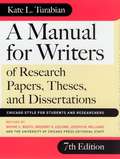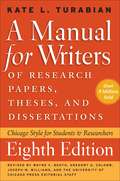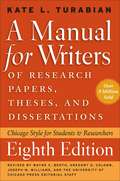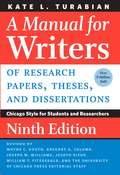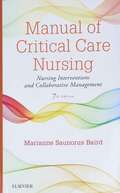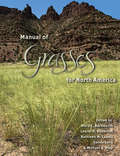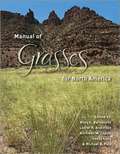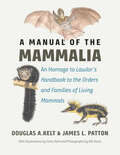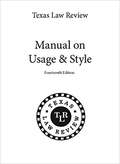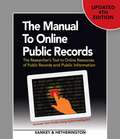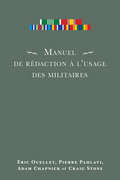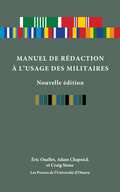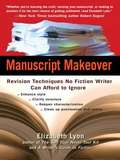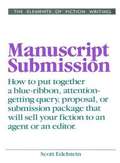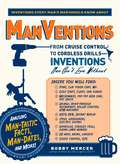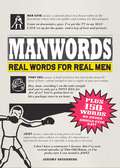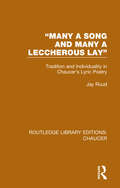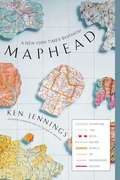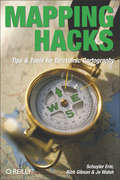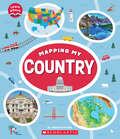- Table View
- List View
A Manual for Writers of Research Papers, Theses, and Dissertations: Chicago Style for Students and Researchers (7th edition)
by Kate L. Turabian Wayne C. Booth Gregory G. Colomb Joseph M. WilliamsThis seventh edition of Turabian's "Manual" is a classic reference revised for a new age. It is tailored to a new generation of writers using tools its original author could not have imagined-- while retaining the clarity and authority that generations of scholars have come to associate with the name Turabian.
A Manual for Writers of Research Papers, Theses, and Dissertations 8th Edition
by Kate L. TurabianA little more than seventy-five years ago, Kate L. Turabian drafted a set of guidelines to help students understand how to write, cite, and formally submit research writing. Seven editions and more than nine million copies later, the name Turabian has become synonymous with best practices in research writing and style. Her Manual for Writers continues to be the gold standard for generations of college and graduate students in virtually all academic disciplines. Now in its eighth edition, A Manual for Writers of Research Papers, Theses, and Dissertations has been fully revised to meet the needs of today's writers and researchers. The Manual retains its familiar three-part structure, beginning with an overview of the steps in the research and writing process, including formulating questions, reading critically, building arguments, and revising drafts. Part II provides an overview of citation practices with detailed information on the two main scholarly citation styles (notes-bibliography and author-date), an array of source types with contemporary examples, and detailed guidance on citing online resources. The final section treats all matters of editorial style, with advice on punctuation, capitalization, spelling, abbreviations, table formatting, and the use of quotations. Style and citation recommendations have been revised throughout to reflect the sixteenth edition of The Chicago Manual of Style. With an appendix on paper format and submission that has been vetted by dissertation officials from across the country and a bibliography with the most up-to-date listing of critical resources available, A Manual for Writers remains the essential resource for students and their teachers.
A Manual for Writers of Research Papers, Theses, and Dissertations, Eighth Edition: Chicago Style for Students and Researchers
by Gregory G. Colomb Joseph M. Williams Kate L. Turabian Wayne C. Booth Wayne C. University of Chicago Press StaffA little more than seventy-five years ago, Kate L. Turabian drafted a set of guidelines to help students understand how to write, cite, and formally submit research writing. Seven editions and more than nine million copies later, the name Turabian has become synonymous with best practices in research writing and style. Her Manual for Writers continues to be the gold standard for generations of college and graduate students in virtually all academic disciplines. Now in its eighth edition, A Manual for Writers of Research Papers, Theses, and Dissertations has been fully revised to meet the needs of today’s writers and researchers. The Manual retains its familiar three-part structure, beginning with an overview of the steps in the research and writing process, including formulating questions, reading critically, building arguments, and revising drafts. Part II provides an overview of citation practices with detailed information on the two main scholarly citation styles (notes-bibliography and author-date), an array of source types with contemporary examples, and detailed guidance on citing online resources. The final section treats all matters of editorial style, with advice on punctuation, capitalization, spelling, abbreviations, table formatting, and the use of quotations. Style and citation recommendations have been revised throughout to reflect the sixteenth edition of The Chicago Manual of Style. With an appendix on paper format and submission that has been vetted by dissertation officials from across the country and a bibliography with the most up-to-date listing of critical resources available, A Manual for Writers remains the essential resource for students and their teachers.
A Manual for Writers of Research Papers, Theses, and Dissertations, Ninth Edition: Chicago Style for Students and Researchers (Chicago Guides to Writing, Editing, and Publishing)
by Joseph M. Williams Kate L. Turabian Wayne C. Booth Gregory G. Colomb Joseph Bizup The University of Chicago Press Editorial Staff William T. FitzGeraldWhen Kate L. Turabian first put her famous guidelines to paper, she could hardly have imagined the world in which today’s students would be conducting research. Yet while the ways in which we research and compose papers may have changed, the fundamentals remain the same: writers need to have a strong research question, construct an evidence-based argument, cite their sources, and structure their work in a logical way. A Manual for Writers of Research Papers, Theses, and Dissertations—also known as “Turabian”—remains one of the most popular books for writers because of its timeless focus on achieving these goals. This new edition filters decades of expertise into modern standards. While previous editions incorporated digital forms of research and writing, this edition goes even further to build information literacy, recognizing that most students will be doing their work largely or entirely online and on screens. Chapters include updated advice on finding, evaluating, and citing a wide range of digital sources and also recognize the evolving use of software for citation management, graphics, and paper format and submission. The ninth edition is fully aligned with the recently released Chicago Manual of Style, 17th edition, as well as with the latest edition of The Craft of Research. Teachers and users of the previous editions will recognize the familiar three-part structure. Part 1 covers every step of the research and writing process, including drafting and revising. Part 2 offers a comprehensive guide to Chicago’s two methods of source citation: notes-bibliography and author-date. Part 3 gets into matters of editorial style and the correct way to present quotations and visual material. A Manual for Writers also covers an issue familiar to writers of all levels: how to conquer the fear of tackling a major writing project. Through eight decades and millions of copies, A Manual for Writers has helped generations shape their ideas into compelling research papers. This new edition will continue to be the gold standard for college and graduate students in virtually all academic disciplines.
Manual of Critical Care Nursing: Nursing Interventions and Collaborative Management
by Marianne Saunorus BairdThe compact, yet comprehensive, Manual of Critical Care Nursing: Nursing Interventions and Collaborative Management, 7th Edition is your students’a go-to reference forto help you provide safe, high-quality nursing care in the clinicalcritical care settings. <p><p>Written in an abbreviated outline format, this easy-to-use Manual presents essential information on more than 75 disorders and conditions, as well as concepts relevant to caring for all critically ill patients and functioning in the critical care environment. Award-winning clinical nurse specialist Marianne Baird separates the content first by body system and then by disorder, with each disorder including a brief description of pathophysiology, assessment, diagnostic testing, collaborative management, nursing diagnoses, desired outcomes, nursing interventions, and patient teaching and rehabilitation. <p><p>With the latest NANDA-I nursing diagnoses and new sections on Bariatric Considerations and Caring for the Elderly, this practical manual is designed to help critical care nurses and nursing students better care for any critically ill patient.
Manual of Grasses for North America
by Mary E. Barkworth Laurel K. Anderton Kathleen M. Capels Sandy Long Michael B. PiepGrasses are the world’s most important plants. They are the dominant species over large parts of the earth’s land surface, a fact that is reflected in the many different words that exist for grasslands, words such as prairie, veldt, palouse, and pampas to mention just a few. As a group, grasses are of major ecological importance, as soil binders and providers of shelter and food for wild animals, both large and small. Some grasses, such as wheat, rice, corn, barley, rye, tef, and sugar cane are major sources of calories for humans and their livestock; others, primarily bamboos, are used for construction, tools, paper, and fabric. More recently, the seed catalogs that tantalize gardeners each winter have borne witness to an increasing appreciation of the aesthetic value of grasses. The Manual of Grasses for North America is designed as a successor to the classic volume by Hitchcock and Chase. It reflects current taxonomic thought and includes keys, illustrations, and distribution maps for the nearly 900 native and 400 introduced species that have been found in North America north of Mexico. In addition, it presents keys and illustrations for several species that are known only in cultivation or are of major agricultural significance, either as progenitors of bread wheat and corn or as a major threat to North American agriculture because of their ability to hybridize with crop species. The Manual is a major reference work for grasses that will retain its value for many years.
Manual of Grasses for North America
by Mary E. Barkworth Laurel K. Anderton Kathleen M. Capels Sandy Long Michael B. PiepGrasses are the world's most important plants. They are the dominant species over large parts of the earth's land surface, a fact that is reflected in the many different words that exist for grasslands, words such as prairie, veldt, palouse, and pampas to mention just a few. As a group, grasses are of major ecological importance, as soil binders and providers of shelter and food for wild animals, both large and small. Some grasses, such as wheat, rice, corn, barley, rye, tef, and sugar cane are major sources of calories for humans and their livestock; others, primarily bamboos, are used for construction, tools, paper, and fabric. More recently, the seed catalogs that tantalize gardeners each winter have borne witness to an increasing appreciation of the aesthetic value of grasses. The Manual of Grasses for North America is designed as a successor to the classic volume by Hitchcock and Chase. It reflects current taxonomic thought and includes keys, illustrations, and distribution maps for the nearly 900 native and 400 introduced species that have been found in North America north of Mexico. In addition, it presents keys and illustrations for several species that are known only in cultivation or are of major agricultural significance, either as progenitors of bread wheat and corn or as a major threat to North American agriculture because of their ability to hybridize with crop species. The Manual is a major reference work for grasses that will retain its value for many years.
A Manual of the Mammalia: An Homage to Lawlor’s “Handbook to the Orders and Families of Living Mammals”
by Douglas A. Kelt James L. PattonThe taxonomy of recent mammals has lately undergone tremendous revision, but it has been decades since the last update to Timothy E. Lawlor’s acclaimed identification guide the Handbook to the Orders and Families of Living Mammals. Integrating the latest advances in research, Douglas A. Kelt and James L. Patton provide this long-overdue update in their new, wholly original work, A Manual of the Mammalia. Complemented by global range maps, high-resolution photographs of skulls and mandibles by Bill Stone, and the outstanding artwork of Fiona Reid, this book provides an overview of biological attributes of each higher taxon while highlighting key and diagnostic characters needed to identify skulls and skins of all recent mammalian orders and most families. Kelt and Patton also place taxa in their currently understood supra-familial clades, and discuss current challenges in higher mammal taxonomy. Including a comprehensive review of mammalian anatomy to provide a foundation for understanding all characters employed throughout, A Manual of the Mammalia is both a user-friendly handbook for students learning to identify higher mammal taxa and a uniquely comprehensive, up-to-date reference for mammalogists and mammal-lovers from across the globe.
El Manual Sobre la Dislexia: Procedimientos Sobre la Dislexia y Trastornos Relacionados (2014)
by Agencia de Educación de TexasUn manual para dislexia y otros trastornos relacionados. Modificado en 2014.
The Manual to Online Public Records: The Researcher's Tool to Online Resources of Public Records and Public Information
by Hetherington Sankey<p>In the 4th edition of The Manual to Online Public Records, authors Sankey and Hetherington shed new light on the mystique of finding public records from government and private sources. The What, Where, and How of online public record access is contained herein on a nationwide basis. <p>Two words epitomize the benefits readers will gain from this completely revised 4th edition: efficiency and accuracy. <p>New chapters explore how to analyze record searching methodology and how to best use social media sites for advanced, creative techniques of finding electronic and paper trails of records. <p>An analysis of 15,000+ government sites is arranged in individual state chapters. Data is presented in a format that is easy-to-use and practical in wording as well as spiked with subjective comments on value and benefits. Readers will soon learn of detailed information on key locations, including data not found from a Google Search. <p>The Manual also provides techniques on how to narrow the overwhelming array of vendors to find those sites that best suit a researcher's needs. <p>More than any of the earlier editions, this resource provides the competitive edge for concise record research.</p>
Manuel de rédaction à l’usage des militaires
by Éric Ouellet Pierre Pahlavi Adam Chapnick Craig StoneLe Manuel de rédaction à l’usage des militaires est un guide de rédaction qui s’adresse aux membres des forces armées appelés à rédiger des textes de qualité dans un style soutenu pour un lectorat militaire averti. Au-delà de l’art de rédiger de manière précise et convaincante, ce manuel fait valoir auprès des militaires gradés qu’une bonne compréhension des rudiments de la rédaction contribue à leur propre efficacité dans leur fonction, tout particulièrement lorsqu’ils accèdent aux rangs supérieurs de l’institution. Le Manuel de rédaction à l’usage des militaires a été développé de manière à habiliter les militaires gradés à aller au-delà de la simple rédaction d’une note de service pour réussir une rédaction plus élaborée qui intègre les règles « universelles » des travaux universitaires. Il aborde divers aspects de la rédaction : l’importance de parfaire ses connaissances et ses habiletés en rédaction; le processus de rédaction et les différences selon le style adopté et les lectorats visés; la méthodologie et la recherche; les questions éthiques comme le plagiat; et les difficultés et les pièges les plus courants. Le dernier chapitre s’avère novateur dans la mesure où il porte sur la façon dont les membres des forces armées peuvent s’inspirer de leur expérience militaire comme élément porteur d’un exercice de rédaction. Des exemples précis, toujours avec un lectorat militaire à l’esprit, complètent le texte. Le Manuel de rédaction à l’usage des militaires est unique en son genre puisqu’il a été conçu spécifiquement à l’intention du personnel des forces armées. Les auteurs Éric Ouellet et Pierre Pahlavi et les collaborateurs Adam Chapnik et Craig Stone sont des professeurs chevronnés qui enseignent au Collège des Forces canadiennes de Toronto. Ce livre, taillé sur mesure pour répondre à un besoin précis, est donc appelé à devenir une référence incontournable dans ce milieu, à l’instar de sa version originale en langue anglaise, Academic Writing for Military Personnel, d’Adam Chapnik et Craig Stone. - Ce livre est publié en français
Manuel de rédaction à l'usage des militaires, nouvelle édition
by Eric Ouellet Adam Chapnick Craig StoneManuel de rédaction à l'usage des militaires est conçu pour aider le personnel militaire à rédiger des textes scientifiques dans un style clair et efficace. Fruit de la collaboration entre un professeur d’écriture chevronné et un officier militaire à la retraite, le manuel s’adresse aux membres des forces armées qui rejoignent le monde universitaire et qui ont déjà rédigé dans un contexte professionnel militaire ou qui n’ont aucune expérience de la rédaction. En plus d’enseigner aux officiers et officières comment rédiger efficacement, ce manuel explique en quoi la maîtrise des techniques de rédaction est utile au personnel des forces armées dans leurs tâches régulières, en particulier aux échelons supérieurs. L’ouvrage traite de l’importance de savoir communiquer par écrit, de ce qui distingue la rédaction savante de la rédaction professionnelle, des processus de recherche et de rédaction proprement dite, du professionnalisme dans la sphère universitaire ainsi que des problèmes et défis fréquemment rencontrés par les rédactrices et les rédacteurs. Un dernier chapitre novateur traite de la manière dont les officiers peuvent mettre à profit les connaissances qu’ils ont acquises par leurs expériences professionnelles dans le contexte universitaire. Des exemples concrets — à l’usage particulier des militaires — sont présentés tout au long du texte pour guider la lectrice et le lecteur de manière pratique et pertinente.Cette édition révisée comprend de nouveaux exemples provenant d’une plus grande variété de sources. Elle prend en compte l’évolution récente des technologies de communication et reflète les nouvelles avancées dans les domaines de l’enseignement et de l’apprentissage.Cet ouvrage, le seul guide exhaustif de rédaction à l’usage du personnel militaire, est un ajout incontournable à la bibliothèque de tout officier et officière militaire, où qu’il se trouve et quel que soit son rang.Ce livre est publié en français. Formats disponibles : couverture souple, PDF accessible et ePub accessible
Manuscript Makeover
by Elizabeth LyonProfessional editor and author Elizabeth Lyon offers aspiring novelists the guidance and instruction they need to write and edit well-crafted and compelling stories that will stand out from the competition and attract the attention of agents and publishers, including: - Stand-out style techniques, from accessing an authentic voice to applying techniques of "wordsmithing" that transform prose - How to rewrite characterization for dimensionality, a universal need, and theme - Adjustment suggestions to match the prose style and structure of specific genres - Correct grammar, punctuation, spelling, and style - Strategies to strengthen story beginnings and endings - Methods for increasing plot stakes, creating movement, and adjusting pace for maximum suspense
Manuscript Submission
by Scott EdelsteinPart of the Elements of Fiction Writing Series, this book will help writer improve their work. It features quality instruction from award-winning authors and focuses on a key facet of fiction writing, making it easy for writers to find the specific guidance they're looking for.
ManVentions
by Bobby MercerGas grills. Riding lawn mowers. Pop-top beer cans.Forget fire and arrowheads and the wheel. The best tools invented by man are such wonders as beer, bikinis, and ESPN. And there's more where they came from, in this hilarious look at the stuff real men are made of:Chow and Suds (microwaves, vending machines, Tabasco sauce)Sports and Recreation (golf carts, cleats, shin guards)Household Gadgets (superglue, Swiss Army knives, Duct tape)Fun and Games (Pong, fantasy football, Wii)Out and About (drive-through restaurants, roller coasters, ATM machines)And More!With fun Man-tastic Facts (bits of trivia) and Man-Dates (important dates in manvention history), this book will remind you why it's great being a man!
ManVentions: From Cruise Control to Cordless Drills - Inventions Men Can't Live Without
by Bobby MercerGas grills. Riding lawn mowers. Pop-top beer cans.Forget fire and arrowheads and the wheel. The best tools invented by man are such wonders as beer, bikinis, and ESPN. And there's more where they came from, in this hilarious look at the stuff real men are made of:Chow and Suds (microwaves, vending machines, Tabasco sauce)Sports and Recreation (golf carts, cleats, shin guards)Household Gadgets (superglue, Swiss Army knives, Duct tape)Fun and Games (Pong, fantasy football, Wii)Out and About (drive-through restaurants, roller coasters, ATM machines)And More! With fun Man-tastic Facts (bits of trivia) and Man-Dates (important dates in manvention history), this book will remind you why it's great being a man!
Manventions
by Bobby MercerGas grills. Riding lawn mowers. Pop-top beer cans. Forget fire and arrowheads and the wheel. The best tools invented by man are such wonders as beer, bikinis, and ESPN. And there's more where they came from, in this hilarious look at the stuff real men are made of:Chow and Suds (microwaves, vending machines, Tabasco sauce)Sports and Recreation (golf carts, cleats, shin guards)Household Gadgets (superglue, Swiss Army knives, Duct tape)Fun and Games (Pong, fantasy football, Wii)Out and About (drive-through restaurants, roller coasters, ATM machines)And More!With fun Man-tastic Facts (bits of trivia) and Man-Dates (important dates in manvention history), this book will remind you why it's great being a man!
ManWords
by Jeremy GreenbergSo your bros are hanging around the grill, shooting the shit while putting back brews from a pony keg. The air's heavy with barbecue sauce, stale belches, and testosterone. And you want to sound manly, like you read Maxim, not GQ. Like you watch football, not gymnastics. You want to use words like "crack-back," "low rider," and "mojo." You need ManWords. If you want to be a high roller, a mac daddy, or a player, you also need this book.And if "taupe," "ruching," and "brow gel" are words you actually know, get this book now. You can probably still be saved.
ManWords: Real Words for Real Men
by Jeremy GreenbergSo your bros are hanging around the grill, shooting the shit while putting back brews from a pony keg. The air's heavy with barbecue sauce, stale belches, and testosterone. And you want to sound manly, like you read Maxim, not GQ. Like you watch football, not gymnastics. You want to use words like "crack-back," "low rider," and "mojo." You need ManWords.If you want to be a high roller, a mac daddy, or a player, you also need this book.And if "taupe," "ruching," and "brow gel" are words you actually know, get this book now. You can probably still be saved.
"Many a Song and Many a Leccherous Lay": Tradition and Individuality in Chaucer's Lyric Poetry (Routledge Library Editions: Chaucer)
by Jay RuudOriginally published in 1992. Although they were apparently much appreciated in his own time, Chaucer’s lyrics have for most of the modern era been the most neglected of his poetic productions. This work offers a comprehensive overview of Chaucer’s lyric corpus. The author extends his scope to include in-depth discussions of literary and cultural influences that have their impact on Chaucer’s lyrics. Students who come to Chaucer’s poems for the first time will here receive an excellent introduction to each poem, the important literary issues surrounding the poem as defined by previous scholarship, and Ruud’s own clear style and balanced judgment. The persuasive proofs for Chaucer’s lyric innovations and his special style of poetry will also be of interest to Chaucerian specialist academics. The book traces Chaucer’s development as a lyric poet, from more conventional early works to more individualized later ones.
Maphead: Charting the Wide, Weird World of Geography Wonks
by Ken JenningsRecord-setting Jeopardy! champion and New York Times bestselling author of Planet Funny Ken Jennings explores the world of maps and map obsessives, &“a literary gem&” (The Atlantic). Ken Jennings takes readers on a world tour of geogeeks from the London Map Fair to the bowels of the Library of Congress, from the prepubescent geniuses at the National Geographic Bee to the computer programmers at Google Earth. Each chapter delves into a different aspect of map culture: highpointing, geocaching, road atlas rallying, even the “unreal estate” charted on the maps of fiction and fantasy. Jennings also considers the ways in which cartography has shaped our history, suggesting that the impulse to make and read maps is as relevant today as it has ever been. From the “Here be dragons” parchment maps of the Age of Discovery to the spinning globes of grade school to the postmodern revolution of digital maps and GPS, Maphead is filled with intriguing details, engaging anecdotes, and enlightening analysis. If you’re an inveterate map lover yourself—or even if you’re among the cartographically clueless who can get lost in a supermarket—let Ken Jennings be your guide to the strange world of mapheads.
Mapping Hacks: Tips & Tools for Electronic Cartography
by Schuyler Erle Rich Gibson Jo WalshSince the dawn of creation, man has designed maps to help identify the space that we occupy. From Lewis and Clark's pencil-sketched maps of mountain trails to Jacques Cousteau's sophisticated charts of the ocean floor, creating maps of the utmost precision has been a constant pursuit. So why should things change now?Well, they shouldn't. The reality is that map creation, or "cartography," has only improved in its ease-of-use over time. In fact, with the recent explosion of inexpensive computing and the growing availability of public mapping data, mapmaking today extends all the way to the ordinary PC user.Mapping Hacks, the latest page-turner from O'Reilly Press, tackles this notion head on. It's a collection of one hundred simple--and mostly free--techniques available to developers and power users who want draw digital maps or otherwise visualize geographic data. Authors Schuyler Erle, Rich Gibson, and Jo Walsh do more than just illuminate the basic concepts of location and cartography, they walk you through the process one step at a time.Mapping Hacks shows you where to find the best sources of geographic data, and then how to integrate that data into your own map. But that's just an appetizer. This comprehensive resource also shows you how to interpret and manipulate unwieldy cartography data, as well as how to incorporate personal photo galleries into your maps. It even provides practical uses for GPS (Global Positioning System) devices--those touch-of-a-button street maps integrated into cars and mobile phones. Just imagine: If Captain Kidd had this technology, we'd all know where to find his buried treasure!With all of these industrial-strength tips and tools, Mapping Hacks effectively takes the sting out of the digital mapmaking and navigational process. Now you can create your own maps for business, pleasure, or entertainment--without ever having to sharpen a single pencil.
Mapping My Country: (learn About) (Learn About)
by Jeanette FerraraA perfect first introduction to maps and map skills for young readers!There are families living in countries across the Americas and all around the world. From Canada, the United States, and Mexico to Central America, countries can look very different but still have a lot in common. Learn how to use map features like a key, compass rose, and a scale to answer questions about direction, measurement, and symbols. Look at photos of different countries, and use the maps inside the book to navigate and compare what is the same and what is different between them. At the end, you will be ready to draw a map of your own country. All this and more in Mapping My Country!ABOUT THIS SERIES:Starting from their bedroom, and moving to their home, street, neighborhood, town, state, country, continent, and finally, planet, children will gain a whole new understanding of their place in the world with this engaging picture book series. With illustrated maps drawn at different scales and vibrant photographs throughout to illustrate real locations, children will learn about map features, how to read maps and answer questions, and how to draw their own maps. Maps are everywhere and understanding them is key to navigating our world. With this brand new and original four-book series, children will expand their role as citizens.
